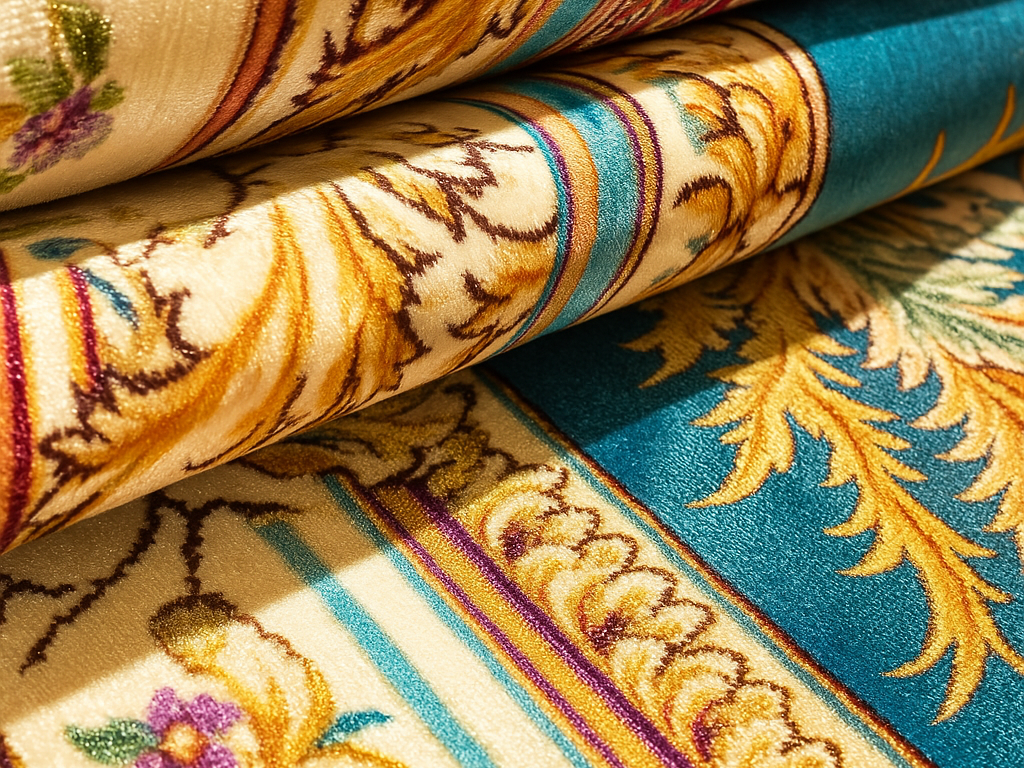그 날카로운 클릭-클릭 딱딱한 바닥에 발뒤꿈치가 부딪히는 소리. 맨 벽에서 울려 퍼지는 컨퍼런스 콜의 메아리. 오후 3시가 되면 에너지를 고갈시키는 차갑고 비인간적인 업무 공간의 느낌. 사무실 환경이 이러한 문제로 어려움을 겪고 있다면 말 그대로 발밑에 해결책이 있을 수 있습니다.
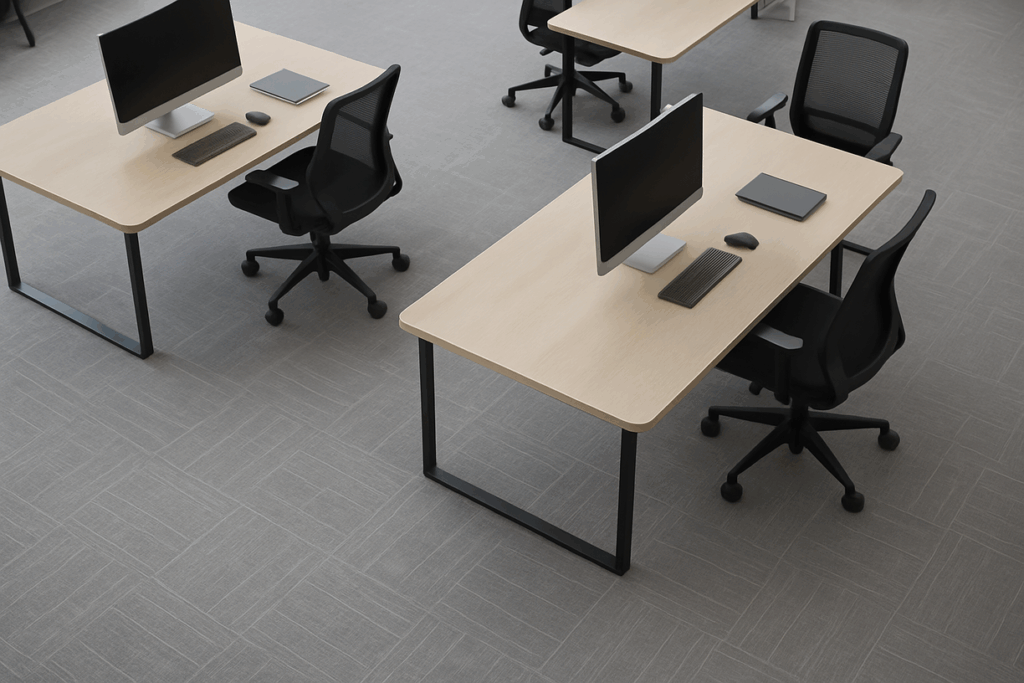
사무실 카펫은 단순히 장식적인 감각 그 이상입니다. 카펫은 소음 공해를 최대 50%까지 줄이고, 미끄러짐 위험을 65%까지 줄이며, 알레르겐을 잡아 공기질을 개선하는 등 실제 업무 공간의 문제를 해결하도록 설계된 전략적 성능 도구입니다. 기능 외에도 색채 심리학을 활용하여 창의성을 높이고 기업의 명성을 드러내는 조용한 브랜드 홍보대사 역할을 합니다.
이 궁극의 가이드에서는 교통량이 많은 구역을 위한 인체공학적 러그 소재부터 혼란스러운 오픈 플랜을 집중된 허브로 바꿔주는 음향 타일 시스템까지 모든 것을 자세히 살펴봅니다.
1. 사무실 러그 이해하기
사무실 러그는 단순한 장식 요소가 아니라 기능적이고 심미적으로 만족스러운 업무 공간을 만드는 데 필수적인 요소입니다. 러그는 발밑의 편안함을 향상시키는 것부터 분주한 사무실 환경의 소음 수준을 줄이는 것까지 다양한 용도로 사용됩니다. 또한 오픈 플랜 오피스 내에서 다양한 영역을 정의하여 공간 구성과 워크플로우 효율성을 돕는 역할도 합니다.
관련 읽기: 적합한 러그 크기를 선택하는 방법: 방별 가이드
2. 사무실 공간에 러그가 필요한 이유
러그를 사무실 환경에 도입하면 단순한 미적 감각을 넘어 다양한 이점을 얻을 수 있습니다. 편안함 향상부터 음향 개선까지, 러그는 기능적이고 매력적인 업무 공간을 만드는 데 중추적인 역할을 합니다.
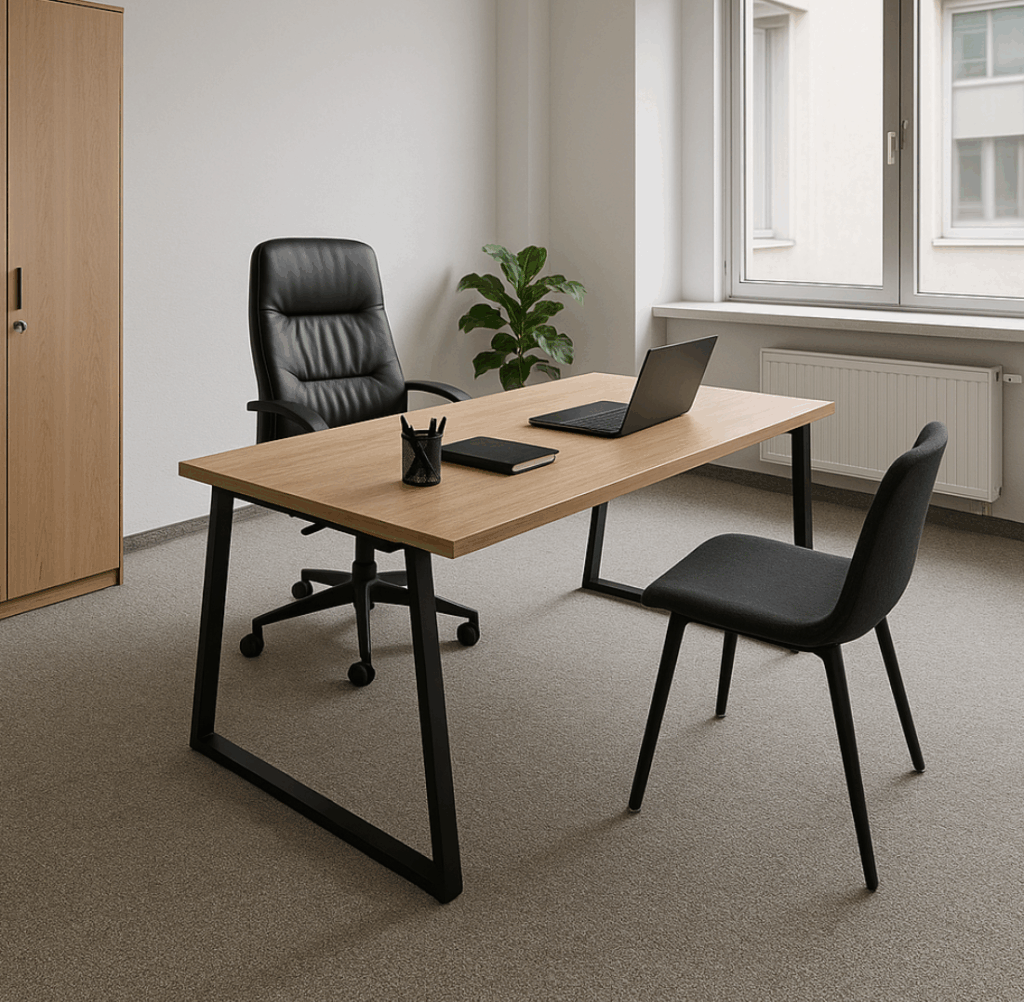
향상된 편안함과 인체공학
타일이나 나무와 같은 딱딱한 바닥 표면은 장시간 근무할 때 불편할 수 있습니다. 사무실 러그는 쿠션감이 있는 표면을 제공하여 발과 관절에 가해지는 부담을 줄여 전반적인 직원들의 편안함과 웰빙에 기여합니다. 이러한 편안함은 생산성 향상과 직원들의 피로 감소로 이어질 수 있습니다.
향상된 음향
소음 공해는 사무실 환경, 특히 개방형 레이아웃에서 흔히 발생하는 문제입니다. 러그는 소리를 흡수하여 에코를 최소화하고 주변 소음 수준을 줄여줍니다. 이는 집중력과 효과적인 커뮤니케이션에 도움이 되는 조용한 환경을 조성합니다.
미적 매력과 브랜딩
러그를 잘 선택하면 다양한 디자인 요소를 하나로 묶어 사무실 공간에 따뜻함과 개성을 더할 수 있습니다. 또한 색상과 패턴 선택을 통해 회사의 브랜드 아이덴티티를 반영하여 고객과 방문객에게 지속적인 인상을 남길 수 있습니다.
공간 정의 및 구성
개방형 오피스 레이아웃에서 러그를 사용하여 워크스테이션, 미팅존, 휴식 공간 등 다양한 기능 영역을 구분할 수 있습니다. 이는 업무 공간을 효율적으로 구성하는 데 도움이 되며 동선을 효과적으로 유도할 수 있습니다.
안전 및 바닥 보호
러그는 특히 교통량이 많은 구역에서 미끄러짐과 낙상을 방지할 수 있습니다. 또한 바닥재가 마모되지 않도록 보호하여 수명을 연장하고 유지보수 비용을 절감할 수 있습니다.
단열
러그는 바닥에 단열층을 추가하여 사무실 내 온도를 쾌적하게 유지하는 데 도움이 됩니다. 이는 추운 기후에서 특히 유용하며 에너지 효율과 직원의 편안함에 기여할 수 있습니다.
관련 읽기: 다이닝룸 러그: 선택, 스타일링 및 관리에 대한 종합 가이드
3. 사무실 러그의 종류
사무실에 적합한 러그를 선택하려면 미적 감각, 기능성, 유지 관리 고려 사항의 균형을 맞춰야 합니다. 다양한 러그 유형은 사무실의 다양한 요구 사항에 맞는 고유한 이점을 제공합니다. 가장 일반적인 유형에 대해 자세히 살펴보세요:
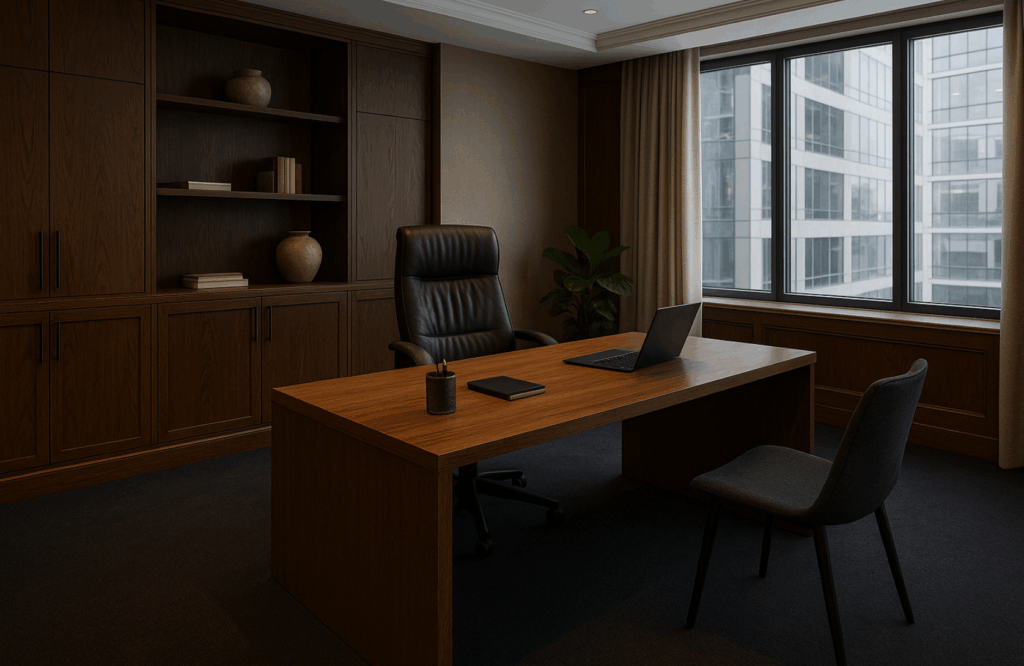
사무실에 적합한 러그를 선택하려면 기능, 심미성, 유지 관리 측면에서 각각 다른 이점을 제공하는 다양한 유형을 이해해야 합니다. 다음은 선택에 도움이 되는 일반적인 사무실 러그 유형에 대한 개요입니다:
로우 파일 러그
로우 파일 러그는 섬유가 짧아 바퀴가 달린 의자를 자주 사용하는 사무실 환경에 이상적입니다. 표면이 평평하여 사무실 의자를 부드럽게 움직일 수 있고 걸려 넘어질 위험이 적습니다. 또한 로우 파일 러그는 청소와 관리가 더 쉬워 교통량이 많은 공간에 적합합니다.
플랫 위브 러그
킬림과 두리와 같은 평직 러그는 파일 없이 제작되어 얇고 튼튼한 러그입니다. 이러한 러그는 가볍고 청소가 쉬우며 양면으로 사용할 수 있는 경우가 많아 활용도가 높습니다. 촘촘하게 짜여져 있어 걸림이 적기 때문에 바쁜 사무실 환경에서 유용하게 사용할 수 있습니다.
실내/실외 러그
다양한 환경에 견딜 수 있도록 설계된 실내/실외 러그는 폴리프로필렌과 같은 내구성이 뛰어난 소재로 제작됩니다. 습기, 얼룩, 변색에 강해 청소하기 쉬운 바닥재 솔루션이 필요한 사무실에 적합합니다. 다용도로 사용할 수 있어 실내 및 반실외 사무실 공간 모두에서 사용할 수 있습니다.
황마 및 천연 섬유 러그
천연 식물 섬유로 만든 황마 러그는 친환경적인 바닥재 옵션입니다. 사무실 공간에 따뜻함을 더할 수 있는 질감이 있고 유기적인 느낌을 줍니다. 황마 러그는 내구성이 뛰어나지만 습기에 취약하고 합성 소재에 비해 더 세심한 관리가 필요할 수 있다는 점에 유의해야 합니다.
울 러그
양모 러그는 부드러움과 내구성으로 유명합니다. 자연적으로 얼룩이 잘 생기지 않고 시간이 지나도 모양이 유지되므로 사무실에 오래 사용할 수 있습니다. 양모의 단열 특성은 소음 감소에도 기여하여 보다 조용한 업무 환경을 조성합니다.
합성 섬유 러그
다음과 같은 합성 섬유로 만든 러그 나일론 또는 폴리에스터는 비용 효율적이며 얼룩과 마모에 대한 저항력이 높습니다. 청소와 관리가 쉬워 통행량이 많은 사무실 공간에 적합합니다. 합성 러그는 다양한 색상과 패턴으로 제공되므로 사무실 디자인에 유연성을 부여할 수 있습니다.
카펫 타일
카펫 타일은 다양한 패턴으로 배치할 수 있고 손상된 경우 쉽게 교체할 수 있는 모듈형 바닥재 옵션입니다. 디자인에 유연성을 제공하며 마모로 인해 레이아웃을 변경하거나 섹션을 교체해야 할 수 있는 사무실에 실용적입니다.
관련 읽기: 패턴의 예술: 프린트 나일론 러그의 디자인 살펴보기
4. 사무실 카펫의 브랜드 심리학
사무실 러그의 선택은 회사 브랜드에 대한 인식에 미묘한 영향을 미칠 수 있습니다. 예를 들어, 세련되고 현대적인 러그 디자인은 혁신과 미래 지향적인 이미지를 전달할 수 있는 반면, 전통적인 패턴은 안정성과 신뢰성을 암시할 수 있습니다. 파란색은 신뢰와 전문성을, 빨간색이나 주황색과 같은 생생한 색상은 창의성과 에너지를 자극할 수 있는 등 색상 선택도 중요한 역할을 합니다.
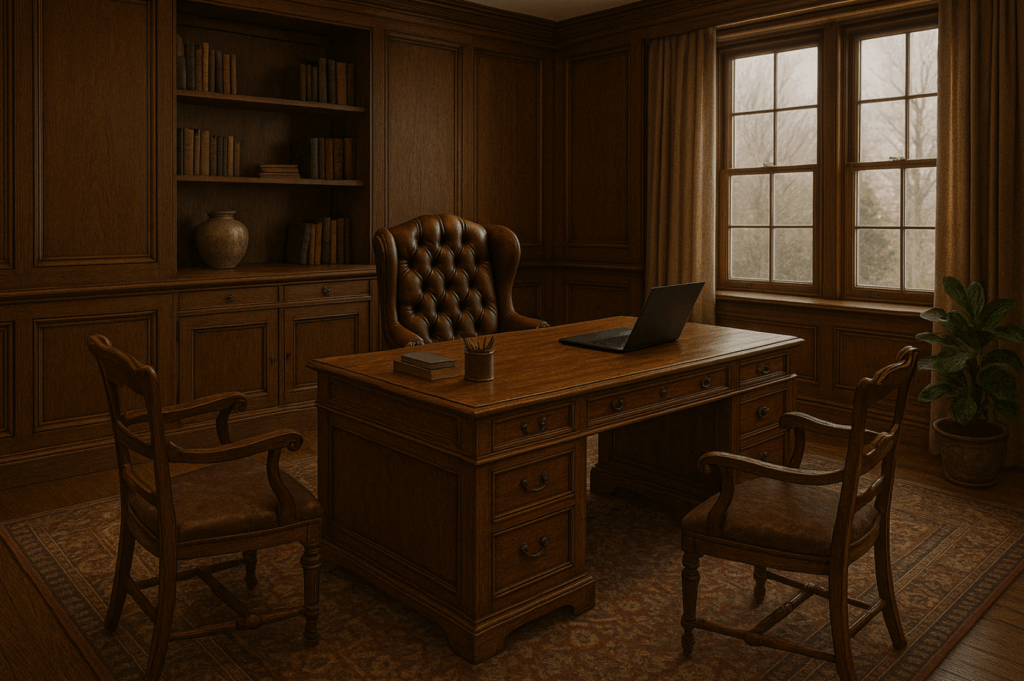
색상 및 패턴 과학
- 딥 블루 & 그레이: 안정성과 신뢰를 전달하며 금융(예: 은행, 로펌)에 이상적입니다.
- 생생한 기하학: 기술 또는 크리에이티브 에이전시에서 혁신을 촉진하세요. 다이나믹 카펫 패턴을 사용하는 선전 스타트업은 브레인스토밍 세션에서 아이디어 창출이 301TP3배 증가했다고 보고했습니다.
- 생체 친화적 그린: 자연 모티브와 결합하면 스트레스를 17%까지 줄여주며, 헬스케어 또는 스트레스가 많은 환경에 적합합니다.
표: 산업별 카펫 색상 심리학
| 산업 | 권장 색상 | 추신생태학적 영향 |
| 금융 | 네이비, 차콜, 버건디 | 신뢰, 권위 |
| 기술/크리에이티브 | 시트러스 옐로우, 청록, 코랄 | 에너지, 혁신 |
| 헬스케어 | 세이지, 스카이 블루, 테라코타 | 진정, 힐링 |
| 교육 | 어스 톤, 따뜻한 레드 | 집중, 자극 |
맞춤형 브랜딩 기회
미래 지향적인 기업들은 현관 카펫에 로고, 사명 선언문 또는 문화적 상징을 엮어 넣습니다. 예를 들어 상하이의 한 핀테크 기업은 리셉션 카펫에 회로 기판 패턴을 삽입하여 방문객이 프런트에 도착하기도 전에 회사의 기술 정신을 강조했습니다.
5. 사무실용 러그를 선택하는 방법
적합한 러그 선택하기 사무실에 적합한 러그는 미적 감각, 기능성, 실용성 사이의 균형입니다. 러그를 잘 선택하면 편안함을 향상하고 공간을 정의하며 브랜드의 정체성을 반영할 수 있습니다. 다음은 선택에 도움이 되는 주요 고려 사항입니다:
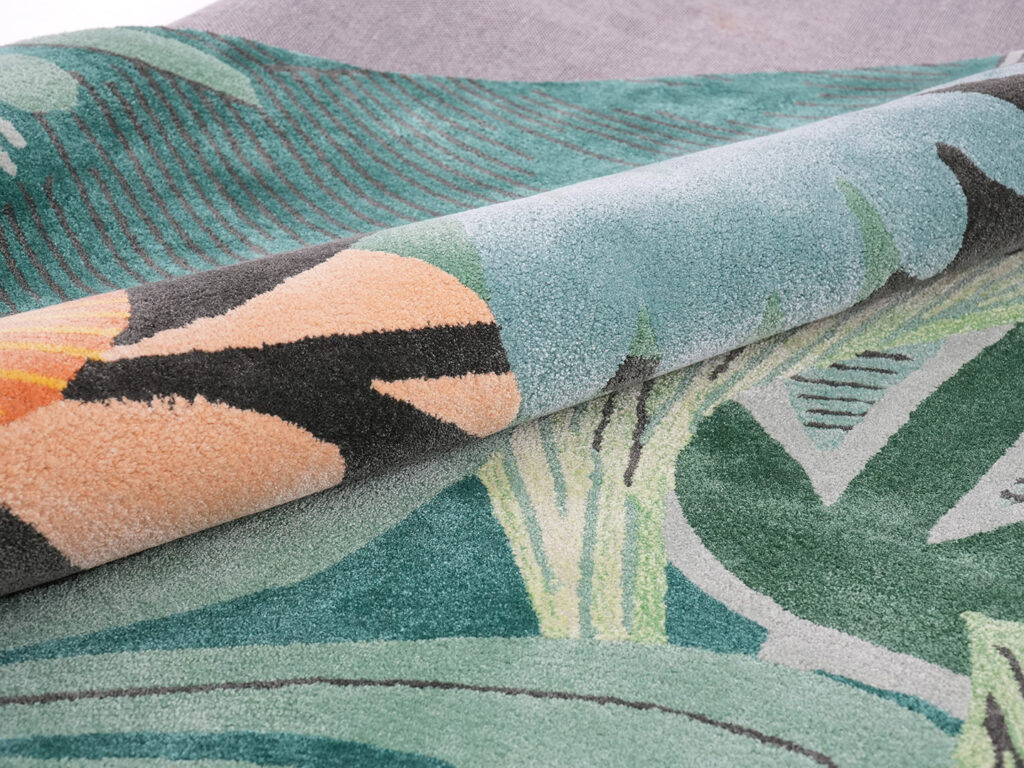
사무실 레이아웃과 목적 평가
- 기능 영역 정의: 책상 공간을 고정할 것인지, 라운지 공간을 꾸밀 것인지, 회의실에 따뜻함을 더할 것인지 등 러그의 용도를 결정하세요.
- 정확한 측정: 공간을 압도하거나 크기가 작아 보이지 않고 러그가 적절하게 맞는지 확인하기 위해 면적을 정확하게 측정하세요.
적절한 크기와 모양 선택
- 데스크 영역: 책상과 의자 너머로 확장되는 러그를 선택하여 편안하게 움직일 수 있도록 하세요.
- 좌석 구역: 러그가 모든 좌석 가구를 수용하여 일관된 모양을 만드는지 확인합니다.
- 오픈 스페이스: 개방형 사무실에서는 큰 러그를 사용하여 뚜렷한 영역이나 통로를 정의하세요.
- 모양 고려 사항: 사무실 레이아웃에 어울리는 러그 모양을 선택하세요. 전통적인 레이아웃에는 직사각형 러그를, 작거나 독특한 모양의 공간에는 원형 러그를 선택하세요.
적합한 자료 선택
- 트래픽이 많은 지역: 나일론이나 폴리프로필렌과 같이 마모에 강하고 세척이 쉬운 내구성 있는 소재를 선택하세요.
- 컴포트 존: 라운지나 개인 사무실과 같이 편안함이 가장 중요한 공간에는 부드러움과 단열성이 뛰어난 울 또는 면 소재 러그를 고려하세요.
- 친환경 옵션: 황마나 사이 잘삼과 같은 천연 섬유는 지속 가능성과 독특한 질감을 제공하지만 관리가 더 필요할 수 있습니다.
파일 높이 및 텍스처 고려
- 로우 파일 러그: 이동이 용이하고 먼지가 쌓일 가능성이 적기 때문에 롤링 의자가 있는 공간에 이상적입니다.
- 하이 파일 러그: 편안함을 더해주며 교통량이 적은 지역에 적합하지만 더 자주 청소해야 할 수 있습니다.
- 텍스처: 사무실의 미적, 기능적 요구사항에 맞는 질감을 선택하세요(예: 평직 러그는 세련된 외관을 제공하고 관리가 쉽습니다).
색상과 패턴을 사무실 미학에 맞추기
- 색채 심리학: 차분함을 원한다면 파란색, 창의성을 원한다면 녹색, 전문적인 느낌을 원한다면 중성적인 톤 등 원하는 분위기를 반영하는 색상을 선택하세요.
- 패턴: 사무실 장식을 보완하는 패턴을 통합하세요. 은은한 패턴은 공간을 압도하지 않으면서도 흥미를 더할 수 있고, 대담한 디자인은 포인트로 활용할 수 있습니다.
유지보수 및 내구성 고려
- 청소의 용이성: 특히 통행량이 많은 곳에서는 청소하기 쉬운 러그를 선택하세요.
- 얼룩 방지: 시간이 지나도 외관을 유지할 수 있도록 얼룩 방지 기능이 있는 러그를 고려하세요.
- 수명: 일상적인 마모를 견디고 모양과 느낌을 유지할 수 있는 고품질 러그에 투자하세요.
예산 고려 사항
- 비용 대비 품질: 예산과 내구성 및 미적 매력의 필요성 사이에서 균형을 잡으세요.
- 장기 투자: 러그의 전반적인 가치를 평가할 때 러그의 수명과 유지 관리 비용을 고려하세요.
6. 사무실 러그 관리 팁
사무실 러그의 외관을 유지하고 건강한 업무 환경을 보장하며 수명을 연장하려면 적절한 관리가 필수적입니다. 다음은 사무실 러그를 최상의 상태로 유지하기 위한 종합적인 팁입니다:
- 정기적인 진공 청소기 청소: 적어도 일주일에 한 번 진공청소기로 청소하여 먼지와 이물질을 제거하여 러그를 깨끗하게 유지하세요.
- 스팟 청소: 얼룩이 생기지 않도록 엎질러진 곳은 즉시 처리하세요. 러그의 재질에 따라 적절한 청소 솔루션을 사용하세요.
- 전문 청소: 러그의 외관과 수명을 유지하기 위해 주기적으로 전문 딥 클리닝을 예약하세요.
- 러그 회전: 특히 교통량이 많은 구역에서는 몇 달에 한 번씩 러그를 교체하여 고르게 마모되도록 하세요.
- 러그 패드를 사용합니다: 미끄러짐을 방지하고 추가적인 쿠션을 제공하기 위해 깔개 패드를 아래에 놓습니다.
7. 사무실 러그 비용
사무실 러그의 가격은 크기, 소재, 디자인에 따라 매우 다양합니다. 예산 친화적인 옵션은 최저 $50부터 시작하지만, 고급 소재로 만든 고급 러그는 수백 달러 이상에 달할 수 있습니다. 고급 러그에 투자하면 내구성과 미적 매력 측면에서 장기적인 이점을 얻을 수 있습니다.
8. 결론
사무실 러그는 모든 업무 공간에 추가할 수 있는 가치 있는 아이템으로 단순한 장식 이상의 이점을 제공합니다. 편안함을 향상시키고 소음을 줄이며 안전에 기여하고 브랜드 아이덴티티를 반영합니다. 올바른 유형, 소재, 디자인을 신중하게 선택하고 적절하게 관리하면 사무실 러그는 업무 공간의 기능과 분위기를 크게 개선할 수 있습니다.
9. 자주 묻는 질문
Q1: 사무실 책상 아래에는 어떤 크기의 러그가 가장 적합하나요?
의자의 움직임을 고려할 때 사방이 책상 너비 24인치 이상 되는 러그가 가장 이상적입니다.
Q2: 바퀴가 달린 사무용 의자에 로우파일 러그가 더 좋은가요?
예. 깔개가 낮으면 바퀴 달린 의자가 쉽게 움직일 수 있고 걸려 넘어질 위험이 적습니다.
Q3: 사무실 러그는 얼마나 자주 전문적으로 청소해야 하나요?
사무실 러그는 유동인구 및 사용량에 따라 12~18개월마다 전문적으로 청소하는 것이 좋습니다.
Q4: 러그가 사무실 음향에 도움이 되나요?
당연하죠. 러그는 소리를 흡수하여 에코와 소음 수준을 줄여 집중력과 생산성을 향상시킬 수 있습니다.
Q5: 사무실을 위한 친환경 러그 옵션이 있나요?
예, 양모, 황마, 대나무와 같은 천연 섬유로 만든 러그는 사무실에 자연스러운 미학을 더하는 친환경적인 선택입니다.

